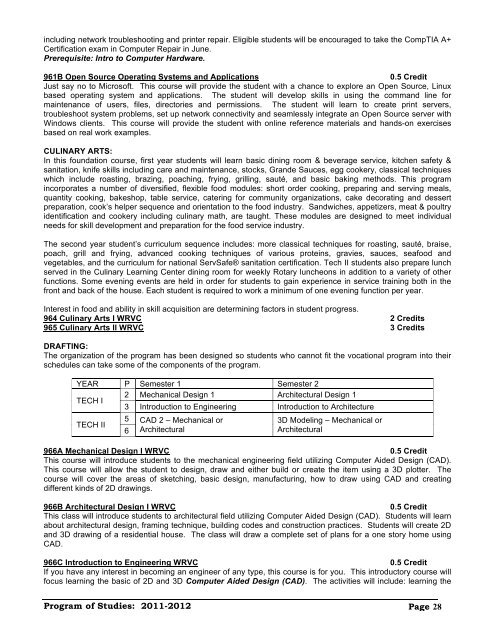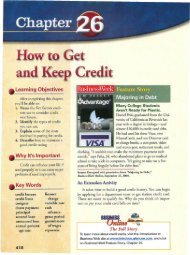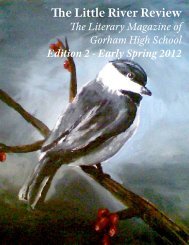Program of Studies 2011-2012 - Gorham High School!
Program of Studies 2011-2012 - Gorham High School!
Program of Studies 2011-2012 - Gorham High School!
You also want an ePaper? Increase the reach of your titles
YUMPU automatically turns print PDFs into web optimized ePapers that Google loves.
including network troubleshooting and printer repair. Eligible students will be encouraged to take the CompTIA A+<br />
Certification exam in Computer Repair in June.<br />
Prerequisite: Intro to Computer Hardware.<br />
961B Open Source Operating Systems and Applications<br />
0.5 Credit<br />
Just say no to Micros<strong>of</strong>t. This course will provide the student with a chance to explore an Open Source, Linux<br />
based operating system and applications. The student will develop skills in using the command line for<br />
maintenance <strong>of</strong> users, files, directories and permissions. The student will learn to create print servers,<br />
troubleshoot system problems, set up network connectivity and seamlessly integrate an Open Source server with<br />
Windows clients. This course will provide the student with online reference materials and hands-on exercises<br />
based on real work examples.<br />
CULINARY ARTS:<br />
In this foundation course, first year students will learn basic dining room & beverage service, kitchen safety &<br />
sanitation, knife skills including care and maintenance, stocks, Grande Sauces, egg cookery, classical techniques<br />
which include roasting, brazing, poaching, frying, grilling, sauté, and basic baking methods. This program<br />
incorporates a number <strong>of</strong> diversified, flexible food modules: short order cooking, preparing and serving meals,<br />
quantity cooking, bakeshop, table service, catering for community organizations, cake decorating and dessert<br />
preparation, cook’s helper sequence and orientation to the food industry. Sandwiches, appetizers, meat & poultry<br />
identification and cookery including culinary math, are taught. These modules are designed to meet individual<br />
needs for skill development and preparation for the food service industry.<br />
The second year student’s curriculum sequence includes: more classical techniques for roasting, sauté, braise,<br />
poach, grill and frying, advanced cooking techniques <strong>of</strong> various proteins, gravies, sauces, seafood and<br />
vegetables, and the curriculum for national ServSafe® sanitation certification. Tech II students also prepare lunch<br />
served in the Culinary Learning Center dining room for weekly Rotary luncheons in addition to a variety <strong>of</strong> other<br />
functions. Some evening events are held in order for students to gain experience in service training both in the<br />
front and back <strong>of</strong> the house. Each student is required to work a minimum <strong>of</strong> one evening function per year.<br />
Interest in food and ability in skill acquisition are determining factors in student progress.<br />
964 Culinary Arts I WRVC 2 Credits<br />
965 Culinary Arts II WRVC 3 Credits<br />
DRAFTING:<br />
The organization <strong>of</strong> the program has been designed so students who cannot fit the vocational program into their<br />
schedules can take some <strong>of</strong> the components <strong>of</strong> the program.<br />
YEAR P Semester 1 Semester 2<br />
2 Mechanical Design 1 Architectural Design 1<br />
TECH I<br />
3 Introduction to Engineering Introduction to Architecture<br />
TECH II<br />
5 CAD 2 – Mechanical or<br />
6 Architectural<br />
3D Modeling – Mechanical or<br />
Architectural<br />
966A Mechanical Design I WRVC<br />
0.5 Credit<br />
This course will introduce students to the mechanical engineering field utilizing Computer Aided Design (CAD).<br />
This course will allow the student to design, draw and either build or create the item using a 3D plotter. The<br />
course will cover the areas <strong>of</strong> sketching, basic design, manufacturing, how to draw using CAD and creating<br />
different kinds <strong>of</strong> 2D drawings.<br />
966B Architectural Design I WRVC<br />
0.5 Credit<br />
This class will introduce students to architectural field utilizing Computer Aided Design (CAD). Students will learn<br />
about architectural design, framing technique, building codes and construction practices. Students will create 2D<br />
and 3D drawing <strong>of</strong> a residential house. The class will draw a complete set <strong>of</strong> plans for a one story home using<br />
CAD.<br />
966C Introduction to Engineering WRVC<br />
0.5 Credit<br />
If you have any interest in becoming an engineer <strong>of</strong> any type, this course is for you. This introductory course will<br />
focus learning the basic <strong>of</strong> 2D and 3D Computer Aided Design (CAD). The activities will include: learning the<br />
<strong>Program</strong> <strong>of</strong> <strong>Studies</strong>: <strong>2011</strong>-<strong>2012</strong> Page 28





